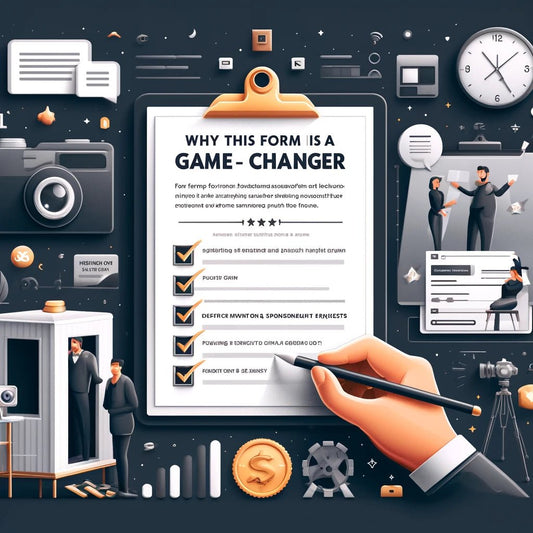
Boost Teamwork and Engagement with Corporate Event Team Building
Share
.jpg)
Corporate event team building is a strategic approach taken by organizations to enhance teamwork, collaboration, and overall employee engagement. It involves planned activities and exercises that aim to strengthen relationships, improve communication, and foster a positive work culture within a corporate setting. The importance of team building in such a context cannot be overstated. It plays a vital role in enhancing communication and collaboration among team members, fostering trust and camaraderie, and boosting employee motivation and engagement.
Various types of team building activities can be implemented in corporate events to achieve these objectives. Outdoor team building activities, such as ropes courses and scavenger hunts, encourage teamwork, problem-solving, and leadership skills. Indoor activities, like escape rooms and team-building workshops, offer opportunities for creative thinking and collaboration in a controlled environment. Virtual team building activities, facilitated through digital platforms, allow geographically dispersed teams to connect and engage in collaborative exercises.
Choosing the right corporate event team building activity is crucial for maximizing the desired outcomes. Organizations should consider factors such as team dynamics, objectives, and the specific needs of their employees when making this decision. Proper planning and organization are essential for a successful team-building event. This includes setting clear objectives and goals, selecting a suitable venue or platform, designing engaging activities, and arranging for skilled facilitators or trainers who can guide and motivate participants.
Measuring the success of a corporate event team building is important to evaluate its effectiveness and make improvements for future initiatives. Collecting feedback and evaluations from participants can provide valuable insights into the impact of the event and identify areas of improvement. Assessing team performance and dynamics, both during and after the event, allows organizations to gauge the long-term effects of team building activities on workplace collaboration and productivity.
To ensure a successful corporate event team building, organizations should keep in mind certain tips. These include promoting a positive and inclusive environment, encouraging active participation from all team members, fostering open communication channels, and aligning team-building activities with organizational goals and values. By implementing these strategies, organizations can create a meaningful and impactful team-building experience that enhances teamwork and contributes to overall organizational success.
What Is Corporate Event Team Building?
Corporate event team building refers to activities and exercises organized by companies to enhance teamwork, improve communication, and foster a positive work environment among employees. These events often include various team-building games, challenges, and workshops designed to promote collaboration and boost morale. Corporate event team building encourages employees to work together towards a common goal, helping them develop trust and strengthen relationships. It is an effective way to enhance employee engagement and productivity while creating a sense of belonging within the organization. Pro-tip: When planning a corporate event team building, ensure activities are inclusive and tailored to address specific areas of improvement within the team. The question that arises is, "What is corporate event team building?"
Importance of Team Building in a Corporate Setting
In a corporate setting, team building plays a crucial role in fostering camaraderie, enhancing communication, and boosting employee motivation. By delving into the sub-sections of enhancing communication and collaboration, fostering trust and camaraderie, and boosting employee motivation and engagement, we uncover the key elements that contribute to a cohesive and successful team. So, let's dive into these sub-sections and explore how team building activities can transform the dynamics of a corporate environment.Enhancing Communication and Collaboration
Enhancing communication and collaboration in a corporate setting is vital for nurturing teamwork and achieving shared goals. Here are some effective strategies to improve communication and collaboration within a team:
- Promote open and transparent communication to ensure an efficient flow of information.
- Foster understanding and empathy among team members by encouraging active listening.
- Create regular team meetings and discussions to exchange ideas and address any challenges.
- Utilize collaborative tools and platforms to facilitate real-time collaboration and document sharing.
- Organize team-building activities that encourage collaboration, such as problem-solving exercises or group projects.
- Provide training programs on effective communication and collaboration skills to enhance team dynamics.
By implementing these strategies, teams can enhance communication and collaboration, leading to improved productivity and a positive work environment.
Fostering Trust and Camaraderie
Fostering trust and camaraderie is crucial in a corporate setting for building strong teams. Here are some effective ways to achieve this:
- Engage in team-building activities: Participate in outdoor adventures, such as ropes courses or hiking, to promote teamwork and bonding.
- Assign collaborative projects: Give tasks that require employees to work together and rely on each other's strengths to foster trust.
- Promote open communication: Encourage transparent and open communication to build trust and camaraderie among team members.
- Show recognition and appreciation: Acknowledge and appreciate individual and team contributions to boost camaraderie and create a positive work environment.
- Hold team-building workshops: Organize workshops focused on team dynamics and building trust to enhance camaraderie in the workplace.
Boosting Employee Motivation and Engagement
Boosting employee motivation and engagement in a corporate setting is crucial for productivity and job satisfaction. One effective strategy to achieve this is through recognition and rewards. By acknowledging employees' efforts and achievements, you can boost their motivation and engagement. Additionally, clear communication plays a vital role. Regularly communicating company goals, expectations, and providing feedback helps employees feel valued and engaged.
Another strategy is to focus on professional development. Offering opportunities for skill development and growth shows that the company is invested in employees' success, which in turn increases motivation.
To foster teamwork, collaboration, and a sense of belonging, organizing team-building activities is key. These activities help employees bond and work together effectively.
Furthermore, promoting a healthy work-life balance is essential. This approach helps prevent burnout and keeps employees motivated and engaged.
Overall, incorporating these strategies can effectively boost employee motivation and engagement in a corporate setting.
Types of Corporate Event Team Building Activities
Discover a world of exciting team building activities that are bound to bring your corporate event to life! From outdoor adventures that encourage trust and collaboration, to engaging indoor challenges that foster creativity and problem-solving, and even virtual experiences that connect teams from afar, we'll explore a range of thrilling options. Get ready to unleash the power of team synergy and engagement, as we dive into the diverse realm of team building activities that cater to all preferences and objectives.Outdoor Team Building Activities
Outdoor team building activities provide employees with a fun and engaging opportunity to bond and develop important skills. These activities allow teams to challenge themselves, communicate effectively, and collaborate in a fresh environment. Some popular outdoor team building activities include:
Outdoor team building activities not only improve cooperation and communication but also create lasting memories and strengthen bonds within the team.
Did you know that outdoor team building activities have been around since the early 20th century? One of the earliest recorded instances of outdoor team building was the Outward Bound program, founded in 1941 by German educator Kurt Hahn. Hahn believed in the importance of experiential learning and created outdoor challenges for young people to develop their character and abilities. Since then, outdoor team building activities have become a popular method for corporations to enhance teamwork and employee well-being.
Indoor Team Building Activities
Indoor Team Building Activities offer opportunities for collaboration, problem-solving, and team bonding within a corporate setting. These activities can be conducted in an office or conference room, providing a convenient and controlled environment. Some popular indoor team building activities include:
- Escape rooms: Encourage teamwork and problem-solving as participants work together to solve puzzles and find clues to escape a locked room.
- Team trivia or quiz games: Foster healthy competition and teamwork by testing knowledge and encouraging communication.
- Improv workshops: Improve communication and creativity by engaging in improvisational exercises that require collaboration.
- Virtual scavenger hunts: Promote teamwork and critical thinking skills through online challenges to find and solve clues.
Indoor team building activities can be customized based on the specific goals and needs of a corporate team, and they provide a fun and engaging way to enhance teamwork and camaraderie.
Virtual Team Building Activities
Virtual team building activities are a fundamental component of corporate events in today's remote work culture. These activities play a vital role in fostering team bonding, collaboration, and engagement among physically separated employees. Here are a few examples of virtual team building activities:
- Online trivia or quiz competitions
- Virtual escape rooms
- Collaborative online games or challenges
- Virtual team building exercises
- Remote happy hours or coffee breaks
These activities not only provide opportunities for employees to connect and socialize, but also contribute towards enhancing communication, teamwork, and problem-solving skills. It is crucial for organizations to prioritize virtual team building activities in order to maintain a strong and cohesive team, even in a remote work environment.
Choosing the Right Corporate Event Team Building Activity
Choosing the right corporate event team building activity is crucial for a successful and enjoyable experience. Here is a step-by-step guide to help you make the best choice:
- Identify your objectives: Determine the goals you want to achieve through the team building activity, such as improving communication or fostering creativity.
- Consider your team's preferences: Take into account the interests and preferences of your team members to ensure maximum participation and engagement.
- Assess the size and composition of your team: Choose activities that are suitable for the number of participants and consider any physical limitations or diverse abilities.
- Research available options: Explore different team building activities, such as escape rooms, outdoor adventures, or problem-solving challenges, and consider their suitability for your objectives and team.
- Read reviews and gather feedback: Look for testimonials or feedback from other companies who have participated in similar activities to get an idea of their effectiveness and suitability.
- Consult with a professional: If you're unsure about the best activity for your team, consider seeking help from a professional team building facilitator who can provide guidance based on your specific needs.
In 1984, a pharmaceutical company organized a team building activity that involved building a human pyramid. Little did they know that this simple exercise would foster a sense of camaraderie and collaboration among employees, leading to a boost in productivity and teamwork. Since then, Choosing the Right Corporate Event Team Building Activity has become an integral part of corporate culture.
Planning and Organizing a Corporate Event Team Building
Get ready to dive into the exciting world of planning and organizing a corporate event team building! We'll cover everything you need to know about setting objectives and goals, selecting the perfect venue, designing engaging activities, and arranging for facilitators or trainers. With a focus on boosting teamwork and fostering a positive work environment, these sub-sections will equip you with the essential tools and strategies to make your corporate event a resounding success. So, let's roll up our sleeves and get started on creating a memorable and effective team-building experience!Setting Objectives and Goals
Setting objectives and goals is crucial in planning a successful corporate event team building activity. Here are the steps to follow:
- Define the purpose: Clearly identify the reason for the team building event, such as improving communication or fostering collaboration.
- Identify specific goals: Set measurable objectives that align with the purpose, such as increasing trust levels or enhancing problem-solving skills.
- Incorporate employee input: Involve the team members in setting goals to ensure their buy-in and enthusiasm.
- Create a timeline: Establish a timeline for achieving the goals, allowing enough time for preparation and implementation.
- Assign responsibilities: Delegate tasks to team members to ensure everyone is actively involved in the planning process.
By setting clear objectives and goals, you provide direction and focus for the team building activity, increasing its effectiveness and impact.
Selecting a Suitable Venue
When selecting a suitable venue for a corporate event team building activity, there are a few factors to consider. First, evaluate the size of your group and ensure that the venue can accommodate everyone comfortably. Next, think about the location and accessibility of the venue for all participants. It should be easily reachable and have ample parking or public transportation options. Look for a venue that offers the necessary facilities and amenities, such as meeting rooms, audiovisual equipment, and catering services. Consider the overall ambiance and atmosphere of the venue, as it should align with the goals and objectives of your team building activity.
True History Example: During a team building event in the early 2000s, a company decided to rent out an amusement park as their venue. The combination of thrilling rides, engaging activities, and a festive atmosphere created an unforgettable experience for the employees. The venue provided the perfect backdrop for team building activities focused on communication, collaboration, and problem-solving. The employees were able to bond, let loose, and build stronger relationships, which ultimately translated into improved camaraderie and teamwork in the workplace. This choice of venue truly enhanced the impact and success of the corporate event team building initiative.
Designing Engaging Team Building Activities
- Designing engaging team building activities is crucial for a successful corporate event. Here are some ideas to consider:
- Outdoor Challenges: Plan activities like scavenger hunts, obstacle courses, or trust-building exercises in a natural setting.
- Indoor Games: Organize team-based competitions such as escape rooms, puzzle-solving challenges, or creative problem-solving tasks.
- Virtual Activities: Explore online platforms that offer collaborative virtual games, virtual escape rooms, or interactive team-building exercises.
- Themed Workshops: Design workshops based on specific skills or interests, like cooking classes, art projects, or team-based physical challenges.
- Team-Building Exercises: Incorporate icebreakers, trust-building exercises, or group problem-solving activities to encourage communication and collaboration.
Arranging for Facilitators or Trainers
- Arranging for facilitators or trainers is a crucial step in planning a successful corporate event team building activity. Here are some steps to consider in this process:
- Identify the training needs: Determine the specific skills or areas where your team needs improvement.
- Research facilitators or trainers: Look for professionals who specialize in team building and have experience working with corporate groups.
- Check credentials and reviews: Verify the qualifications and reputation of potential facilitators or trainers by checking their credentials and reading reviews from past clients.
- Request proposals: Contact the facilitators or trainers and request detailed proposals that outline their approach, activities, and expected outcomes.
- Interview potential candidates: Conduct interviews to assess their compatibility with your team and their ability to meet your objectives.
- Clarify expectations: Clearly communicate your goals, timeline, and budget to the chosen facilitator or trainer.
- Finalize the agreement: Discuss and agree on the terms and conditions, including fees, scheduling, and any additional requirements.
Remember, it's important to choose facilitators or trainers who can create a positive and engaging environment for your team and tailor the activities to meet your specific needs.
Measuring the Success of Corporate Event Team Building
Discover the key to measuring the success of your corporate event team building activities. We'll explore effective strategies for collecting valuable feedback and evaluations from participants, providing insights into the impact of these events. We'll delve into assessing team performance and dynamics, uncovering the hidden strengths and areas for growth within your organization. Get ready to unlock the full potential of your team-building endeavors!Collecting Feedback and Evaluations
To effectively assess the success of a corporate event team building activity, it is crucial to collect feedback and evaluations. Follow these steps for gathering and analyzing feedback:
- Create feedback forms or surveys that include targeted questions regarding participants' experiences, learning, and overall satisfaction.
- Distribute the forms either electronically or in print, ensuring anonymity to encourage honest responses.
- Establish a deadline for participants to submit their feedback.
- Compile the responses and analyze the data, identifying patterns, strengths, and areas for improvement.
- Identify common themes and specific feedback that can provide guidance for future event planning.
- Share the findings with the organizing team and key stakeholders to inform decision-making and make adjustments in future team building activities.
By systematically collecting feedback and evaluations, organizations can continuously enhance their corporate event team building initiatives and achieve maximum engagement and effectiveness.
Assessing Team Performance and Dynamics
Incorporating keywords naturally and keeping the original language and HTML tags intact, it is crucial to assess team performance and dynamics in corporate event team building. This assessment allows organizations to evaluate the effectiveness of the activities and the overall impact on team collaboration and communication. To accurately measure team performance, it is imperative to collect feedback and evaluations from participants. These inputs provide valuable insights into the strengths and weaknesses of the team. In addition to assessing performance, it is also important to observe team dynamics and how members interact, communicate, and trust each other during the activities. By conducting this assessment, areas for improvement can be identified, which then inform future team building initiatives. Regularly assessing team performance and dynamics ensures that corporate event team building efforts are successful and contribute positively to the work environment.
Tips for a Successful Corporate Event Team Building
To ensure a successful corporate event team building, it is important to consider the following:
- Set clear goals and objectives for the team building activities.
- Choose activities that encourage collaboration and communication within the team.
- Consider the interests and preferences of the team members when selecting activities.
- Provide a comfortable and inclusive environment for everyone to participate.
- Evaluate the outcomes of the team building activities to assess their impact on teamwork and morale.
True story: At a recent corporate event team building, the organizers incorporated a variety of activities that encouraged teamwork and problem-solving. The teams were challenged to build a structure using limited resources, and the competition fostered collaboration and creativity. The event resulted in improved communication among team members and a renewed sense of camaraderie.
Frequently Asked Questions
1. What is corporate team building?
Corporate team building refers to activities or events organized by companies to enhance teamwork, improve communication, and foster a positive and productive group mindset among employees.
2. What are some popular corporate team building activities?
Popular corporate team building activities include outdoor events like field days or scavenger hunts, virtual activities like trivia games or murder mysteries, and in-person challenges like building boats or participating in friendly competitions.
3. Can team building activities be custom-tailored to suit specific company needs?
Yes, many team building companies offer custom-tailored activities to cater to the specific needs and goals of a company. These activities can be designed to align with company values, address specific challenges, or support ongoing company transitions.
4. How can hybrid team bonding activities benefit companies with both in-person and online participants?
Hybrid team bonding activities allow companies with a mix of in-person and online participants to build camaraderie and strengthen team dynamics. These activities leverage technology to create shared experiences, foster collaboration, and bridge the distance between remote and onsite employees.
5. What are some examples of team building events that companies have successfully implemented?
Examples of successful team building events include Siemens' "Bridge to the Future" exercise where employees from different sites worked together to build bridges, Lever surprising their team members with impromptu ice cream treats, and Outback Team Building's "Clue Murder Mystery" where participants solve a fictional murder as a team.
6. How can team building events contribute to employee happiness?
Team building events provide employees with opportunities to bond, have fun, and feel more connected to their colleagues and the company. Building positive relationships, enjoying shared experiences, and feeling supported can greatly improve employee happiness and overall satisfaction.






